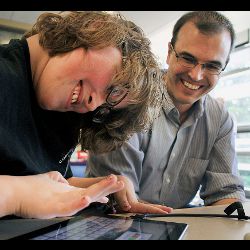
“Lacking diversity on an engineering team, we limit the set of solutions that will be considered and we may not find the best, the elegant solution.”8 This insight, as expressed by computer scientist William A. Wulf, has motivated efforts to encourage women and racial/ethnic minorities to pursue computing careers. However, the underrepresentation of individuals with disabilities in these disciplines has been largely ignored. Not so at the University of Washington. Our AccessComputing initiative has worked tirelessly in this domain at a national level and, over a decade, has achieved promising outcomes in increasing the number of people with disabilities completing degrees and pursuing careers in computing fields. AccessComputing efforts have increased the capacity of key players—postsecondary institutions, professional organizations, and industry—to fully include individuals with disabilities and helped individuals with disabilities move toward computing degrees and careers.1 In this column, we share examples of project activities and lessons learned to encourage other educators and employers to join our efforts in increasing diversity in computing disciplines by engaging more individuals with disabilities in these professions.
The Need
Increasing the participation of individuals with disabilities in computing fields is not just a matter of quantity. Engaging this population can help us meet the mandate the National Science Foundation (NSF) to support “the best ideas from the most capable researchers and educators.”6 This applies to the design of information technology (IT) to be accessible to a broad audience and preparation of professionals with accessibility skills to help employers meet legal mandates under the Americans with Disabilities Act (ADA) and address the needs of an aging population. Individuals with disabilities are uniquely suited to contribute to this effort. However, people with disabilities face challenges in pursuing science, technology, engineering, and mathematics (STEM), completing degrees and succeeding in careers. Student veterans with post-traumatic stress disorder and traumatic brain injury, “signature injuries” of recent conflicts, can face additional challenges related to social adjustment, finances, and adjustment to their disabilities.3
Increasing the participation of individuals with disabilities in computing fields is not just a matter of quantity.
One ongoing challenge to address is ensuring the availability of information technology that is accessible to everyone. There are well-documented solutions for making IT accessible; they help with access to keyboards and mice for those with limited mobility, to content within images for students who are blind, and to audio content for students who are deaf or hard of hearing.7 Students with learning disabilities or who have difficulty with focus, reading comprehension, or other cognitive issues can benefit from inclusive instructional approaches that do not make them stand out as different.5 The success stories of the relatively few individuals with disabilities in computing fields demonstrate the opportunities for those who develop academic and self-determination skills and who overcome inaccessibility in facilities, curricula, and IT and inadequate academic support. However, the biggest barrier is often lack of encouragement by individuals with whom they interact, including educators and employers. Integrating content about how IT can improve the lives of individuals with disabilities in computing courses can encourage students with disabilities and others interested in social impact who may not otherwise consider the computing field.
AccessComputing: It Is About Engaging Professionals
AccessComputing was created in 2006 to address the need to increase diversity in computing by including more individuals with disabilities. Funded by the NSF, the initiative engages individuals with disabilities as well as those who support, educate, and employ them, in sustainable practices for making computing disciplines more welcoming and accessible to people with disabilities. Project objectives fall into two areas:
- Organizational capacity development: Increase the capacity of postsecondary institutions, organizations that broaden participation in computing, and industry to fully include individuals with disabilities in computing fields.
- Individual participation: Implement evidence-based practices (for example, workshops, mentoring, internships) to increase the number of individuals with disabilities moving through critical junctures to computing careers.
Bringing together multiple stakeholder groups is a key to AccessComputing‘s success. This starts with leadership. As its leaders, we represent the Department of Computer Science and Engineering and the DO-IT (Disabilities, Opportunities, Internetworking, and Technology) Center, both at the University of Washington. Together, we have a depth of experience in computer science as well as access issues and solutions for individuals with disabilities. In addition, AccessComputing engages 58 project partners who represent a diverse set of postsecondary institutions and computing organizations. Three of our partners, National Technical Institute for the Deaf at Rochester Institute of Technology, Gallaudet University, and Landmark College, serve students with disabilities as a specific mission. Institutional representatives engage online and onsite to explore promising practices and develop resources that enhance understanding and promote replication at educational institutions, in professional organizations, and in the computing industry.
AccessComputing leaders have also worked with 175 collaborators, some who have hosted student interns and others who have hosted events for students with disabilities or faculty and staff at their sites. We have awarded 75 mini-grants to collaborators to help fund their activities that support the project objectives. We have worked with 78 computing departments and professional organizations to help make them more accessible and welcoming to people with disabilities. Examples include working with 21 computing departments to evaluate and help improve the accessibility of their websites; with ACM SIGCHI in its efforts to make CHI conferences more accessible; with our partner, Center for Minorities and People with Disabilities in IT (CMD-IT), in its efforts to make the Tapia Conference, Academic Careers Workshop, and its other activities more accessible and welcoming to people with disabilities; and EDU-CAUSE in making its events more accessible and to address disability-related topics in its conference exhibits and presentations. We have also worked with partners and collaborators to expand the AccessComputing online searchable knowledge base of 487 questions and answers, case studies, and evidence-based practices that can help leaders and practitioners make computing disciplines more inclusive.1
AccessComputing: It Is About Engaging People with Disabilities
Over the past 10 years almost 450 students around the U.S. have participated in the AccessComputing Team, an online community of computing students. They have engaged with peer and career mentors, in research and industrial internships, and professional conferences and other career development activities. Of the 410 AccessComputing internships, 110 were research internships at various universities. The outcomes of participation are impressive. For example, in a follow-up survey, 151 AccessComputing interns rated six statements on a 5-point scale, where 1 is “strongly disagree” and 5 is “strongly agree.” The items and average responses are represented in the accompanying table.
One ongoing challenge to address is ensuring the availability of information technology that is accessible to everyone.
These results are consistent with an earlier study where STEM interns with disabilities reported increased motivation to work toward a career, knowledge about careers and the workplace, job-related skills, ability to work with supervisors and coworkers, and self-advocacy skills.2 Profiles of 17 AccessComputing Team members are highlighted on the Choose Computing web page of our website.1
Bringing together multiple stakeholder groups is a key to AccessComputing’s success.
We measure project impact by gathering participant feedback and by tracking the progress of student participants. AccessComputing participants are tracked through critical junctures4 to computing degrees and careers. Some AccessComputing participants participate in the AccessSTEM/AccessComputing/DO-IT Longitudinal Transition Study (ALTS), an ongoing research study that tracks the progress of students with disabilities through critical junctures to postsecondary degrees and careers. Analysis of results supports the efficacy of evidence-based interventions by documenting higher levels of success—in terms of high school graduation, college attendance/persistence, computing majors/degrees and careers—of participants with disabilities than of people with disabilities in comparison groups.
Lessons Learned
A decade of AccessComputing efforts has resulted in students with disabilities moving through critical junctures to computing degrees and careers; increased capacity of computing faculty and professional organizations to include participants with disabilities; useful resources for educators and employers; and sustained engagements of stakeholder groups. Others who want to host a project like AccessComputing can benefit from what we have learned. For example, we have learned that positive outcomes result from cooperative efforts between organizations focused on computing and those focused on disability and that new activities benefit from facilitation by experienced staff and provision of external funding for initial activities on which institutionalization can build.
Many lessons have been learned with respect to the participation of students with disabilities in computing fields.
- Individuals face common issues as well as unique challenges related to specific disabilities, in both academic and non-academic (for example, self-advocacy) arenas.
- Motivational activities should be undertaken to recruit students without initial interest in computing.
- For students with disabilities interested in computing, comprehensive preparation and retention interventions should be undertaken in order to produce more positive outcomes than isolated efforts.
- We need to develop more leaders and role models with disabilities in computing fields by undertaking more efforts like AccessComputing.
- Aggressive retention efforts are essential because the percentage of students in computing majors who have disabilities decreases as education levels increase.
Much has been learned about organizational capacity development as well.
- Computing departments, programs, and professional organizations should be welcoming and accessible to people with disabilities, consulting individuals with disabilities and/or disability services to make accessibility a centerpiece of the organization. Being responsive to legal obligations means designing for accessibility and providing instructions for requesting accommodations.
- Employers need to become more aware of how they can benefit from hiring employees with disabilities because addressing accessibility challenges in their daily lives has made this group good problem solvers.
- Both students and employees with disabilities provide unique perspectives on the usability of products and services that benefit academic programs and industry.
- Instructors and employers should consult with individuals with disabilities about what will make them most productive in computing activities; after all, they are the experts about their own access challenges and solutions.
Conclusion
Evaluation results of AccessComputing activities suggest that computing departments, professional organizations, and employment opportunities have become more accessible and welcoming because of the engagement between AccessComputing partners and collaborators. Many individual students have been positively impacted by their participation in the project as well. Clearly, much has been accomplished. But critical work remains to be done by AccessComputing and complementary projects. NSF has demonstrated its agreement with this conclusion by authorizing five more years of funding for the AccessComputing initiative. The renewal of the grant will particularly focus on the following new areas:
- Supporting the integration relevant disability/accessibility/universal design content into computing courses in order to increase knowledge and skills among future computing professionals.
- Engaging the computing industry to increase focus on placement of individuals with disabilities in careers.
Those interested in moving this diversity agenda forward should consult the AccessComputing website at http://www.uw.edu/accesscomputing or contact us at accesscomputing@uw.edu. Ultimately, outcomes of projects like AccessComputing will benefit society by making computing opportunities available to more people and by enhancing computing fields with the talents and perspectives of people with disabilities.
Figures
 Figure. A student engages with a computer through a touchscreen.
Figure. A student engages with a computer through a touchscreen.
 Figure. A student uses a speech interface to gain the functionality of a keyboard and mouse.
Figure. A student uses a speech interface to gain the functionality of a keyboard and mouse.





Join the Discussion (0)
Become a Member or Sign In to Post a Comment